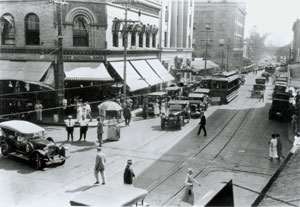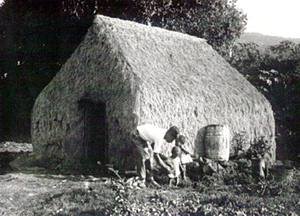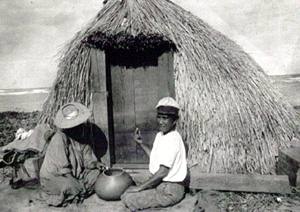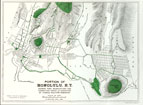Types of Materials: Newspapers and Other Periodicals
Considering its geographic size, Hawai'i has produced a remarkable number of newspapers, magazines, and other periodicals. Within a generation or two of western contact, many Hawaiians were literate in the missionary version of their written language, and many in English as well. The result was a number of Hawaiian language newspapers, many of which took an oppositional stance to the dominant Euroamerican narrative. The Honolulu Star-Bulletin (1882) and Honolulu Advertiser (1856) are the newspapers of record for Hawai'i and are indexed starting in 1929. However, they are not by any means the only periodical sources. Helen Geracimos Chapin has chronicled the history of newspapers in Shaping History: The Role of Newspapers in Hawai'i. She presents a detailed survey of the newspaper industry in Hawai'i and describes dozens of small and large local periodicals, many of which survive today on microfilm. The neighbor island papers are also available on microfilm and partially indexed. Hamilton Library has a clippings morgue of articles organized by name and by subject from the Star-Bulletin and Advertiser.

Rubellite Johnson and Esther Mo'okini have chronicled Hawaiian language newspapers. Johnson's Ku kui 'A ha'ilono Carry on the News (1976) provides translations of articles from a variety of Hawaiian language newspapers between 1834-1948 as well as a brief survey of the history of Hawaiian newspapers. Esther Mo'okini's The Hawaiian Newspapers is a comprehensive listing of Hawaiian language newspapers during the same period.
Students with facility in languages other than English should be cognizant of the fact that every ethnic community produced newspapers in their native language. For example, Hawai'i Hochi and Nippu Jiji, two of the larger Japanese language newspapers in Honolulu are rich sources of information and commentary about the Japanese American community. Both papers also had English editions, usually a two to three page insert that featured editorials and the most important local news stories. The newspapers competed with one another in circulation on O'ahu. Fred Makino at the Hochi and Yasutaro Soga at the Nippu Jiji had been comrades during the failed 1909 labor strike, but they subsequently became rivals, even enemies. (See Tom Brislin's "Weep into Silence/Cries of Rage: Bitter Divisions in Hawai'is Japanese Press.")

Two other periodicals are noteworthy: Paradise of the Pacific and Mid-Pacific Magazine. These glossy periodicals were produced locally but enjoyed a substantial readership in North America and internationally. Both were in the business of promoting Hawai'i as a tourist destination and a place for business investment. Paradise of the Pacific, which survives today as Honolulu Magazine, is the oldest continuing periodical published west of the Mississippi (1888). Mid-Pacific Magazine was the brain-child of Alexander Hume Ford, one of the more notorious of Hawai'i promoters. He founded the magazine in 1911 as a means of promoting international peace through tourism and trade. A life-long advocate of Pacific relations, Mid-Pacific reflected Ford's fascination with the white man's burden in the Pacific.
Thrum's Annual is part Farmer's Almanac, part academic journal, part tourist promotion magazine and was compiled yearly beginning in 1875. (It was later known as the Hawaiian Annual.) Besides providing a yearly chronicle of rainfall, average temperatures and population statistics, it also featured articles regarding Hawaiian history, geology, climatology, and social life and customs. (For a biographical sketch of Thomas Thrum, see Ralph Kuykendall, "Thomas George Thrum, A Sketch of His Life." Hawaiian Annual , 1933.) Other periodical sources are academic journals produced at the University of Hawai'i.
Social Process in Hawai'i is possibly the most important source of primary sociological interpretation during the early Territorial period. Begun by Romanzo Adams, the founding member of the Sociology department at UH, Social Process was a student/faculty venture for years. Undergraduate and graduate researchers used the raw materials of their term papers to help build Adams' collection of data on ethnic diversity in Hawai'i. Although the articles are not all polished academic prose, they reveal a fresh and unmediated view of Hawai'i from the perspective of local students.

Important English Language Newspapers:
Hawai'i Newspapers: Union List, Honolulu: Hawai'i
Newspaper Project, 1987
The Daily Bulletin/The Hawaiian Star/Honolulu Star
Bulletin
Pacific Commercial Advertiser/Honolulu Advertiser
The Polynesian
The Friend
Ka Leo O Hawai'i
Honolulu Record
Sources on Hawai'i's Newspapers:
A comprehensive list is contained in Hawaii
Newspapers from the Hawai'i Newspaper Project.
Ballou, Howard Malcolm and George R. Carter. "The History of
the Hawaiian Mission Press" in Fourteenth Annual Report
of the Hawaiian Historical Society, Honolulu, n.d.
Chapin, Helen Geracimos. "From Makaweli to Kohala: The
Plantation Newspapers of Hawai'i." The Hawaiian Journal
of History. 23 (1989): 170-195.
Chapin, Helen Geracimos. "Newspapers of Hawai'i 1834 to
1903: From He Liona to the Pacific Cable." The Hawaiian
Journal of History 18 (1984): 47-86.
Lai, Him Mark. "The Chinese Community Press in Hawai'i." In
The Ethnic Press in the United States: An Analysis and
Handbook. Sally Miller, Ed. New York: Greenwood Press,
1987.
Yzendorn, Father Reginald. "Establishment of the First
English Newspaper in the Hawaiian islands." In
Twenty-second Annual Report of the Hawaiian Historical
Society, 1913. Honolulu: Paradise of the Pacific,
1914.
Academic periodicals include:
Hawaiian Journal of History
Bishop Museum Occasional Papers
Hawai'i Historical Review
Journal of Pacific History
Social Process in Hawai'i
Contemporary Pacific
Hawai'i Bar Journal


